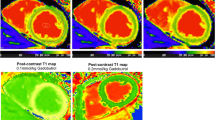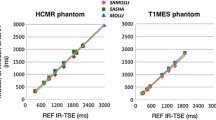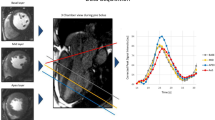Abstract
Flow and pressure variations cause potential changes in magnetic resonance imaging (MRI) signal intensity across the cardiac cycle. Nevertheless, cardiac dynamic contrast-enhanced (perfusion) MRI is performed and analyzed regardless of the cardiac phase. We investigate whether the cardiac phase impacts myocardial and left ventricle (LV) cavity time intensity curves (TICs) at rest and during vasodilatation. Fifteen healthy volunteers (seven females, eight males; mean age: 32.5 ± 9.3 years; age range: 19–49 years) were included in this prospective study. They underwent four separate short-axis multislice (apical, mid and basal) LV perfusion MRI, with different electrocardiogram-triggering during normal vasotone and adenosine-stress. TIC parameters were extracted from the myocardium and the LV cavity. General linear mixed model analyses were used to evaluate their variability according to vasotone, cardiac phase and slice-position. Maximal enhancement and normalized Steepest slopes were higher at stress than at rest (p values <0.001). A similar trend towards higher inflow was shown on systole versus diastole in the LV cavity and diastole versus systole in the myocardium (p < 0.05).These TIC parameters were slice-position dependent, as the inflow decreased from the base to the apex in the LV, and peaked on the mid-slice for the myocardium. There are significant variability of both the LV and the myocardial TICs, with respect to the cardiac cycle phase and the slice position where imaging actually takes place. These appeal to measurement standardization for a better intra- and inter-study reproducibility.



Similar content being viewed by others
References
Ishida M, Kato S, Sakuma H (2009) Cardiac MRI in ischemic heart disease. Circ J 73(9):1577–1588
Nagel E et al (2003) Magnetic resonance perfusion measurements for the noninvasive detection of coronary artery disease. Circulation 108(4):432–437
Gerber BL et al (2008) Myocardial first-pass perfusion cardiovascular magnetic resonance: history, theory, and current state of the art. J Cardiovasc Magn Reson 10:18
Kellman P, Arai AE (2007) Imaging sequences for first pass perfusion—a review. J Cardiovasc Magn Reson 9(3):525–537
Lerman BB, Belardinelli L (1991) Cardiac electrophysiology of adenosine. Basic and clinical concepts. Circulation 83(5):1499–1509
Gould KL, Kirkeeide RL, Buchi M (1990) Coronary flow reserve as a physiologic measure of stenosis severity. J Am Coll Cardiol 15(2):459–474
Chilian WM, Marcus ML (1982) Phasic coronary blood flow velocity in intramural and epicardial coronary arteries. Circ Res 50(6):775–781
Radjenovic A et al (2010) Estimates of systolic and diastolic myocardial blood flow by dynamic contrast-enhanced MRI. Magn Reson Med 64(6):1696–1703
Motwani M et al (2012) Systolic versus diastolic acquisition in myocardial perfusion MR imaging. Radiology 262(3):816–823
Larghat A et al (2012) Endocardial and epicardial myocardial perfusion determined by semi-quantitative and quantitative myocardial perfusion magnetic resonance. Int J Cardiovasc Imaging 28(6):1499–1511
Austin RE Jr et al (1990) Profound spatial heterogeneity of coronary reserve. Discordance between patterns of resting and maximal myocardial blood flow. Circ Res 67(2):319–331
Diamond GA, Forrester JS (1979) Analysis of probability as an aid in the clinical diagnosis of coronary-artery disease. N Engl J Med 300(24):1350–1358
Deshpande VS et al (2003) Reduction of transient signal oscillations in true-FISP using a linear flip angle series magnetization preparation. Magn Reson Med 49(1):151–157
Boudoulas H et al (1981) Linear relationship between electrical systole, mechanical systole, and heart rate. Chest 80(5):613–617
Jerosch-Herold M et al (2004) Analysis of myocardial perfusion MRI. J Magn Reson Imaging 19(6):758–770
Thompson HK Jr et al (1964) Indicator transit time considered as a gamma variate. Circ Res 14:502–515
Klocke FJ et al (2001) Limits of detection of regional differences in vasodilated flow in viable myocardium by first-pass magnetic resonance perfusion imaging. Circulation 104(20):2412–2416
Edelman RR (1992) Basic principles of magnetic resonance angiography. Cardiovasc Intervent Radiol 15(1):3–13
Parkka JP et al (2006) Comparison of MRI and positron emission tomography for measuring myocardial perfusion reserve in healthy humans. Magn Reson Med 55(4):772–779
Peeters F et al (2004) Inflow correction of hepatic perfusion measurements using T1-weighted, fast gradient-echo, contrast-enhanced MRI. Magn Reson Med 51(4):710–717
Ibrahim T et al (2002) Assessment of coronary flow reserve: comparison between contrast-enhanced magnetic resonance imaging and positron emission tomography. J Am Coll Cardiol 39(5):864–870
Nchimi A et al (2014) Myocardial dynamic contrast-enhanced Mr: vascular diseases and beyond. JBR-BTR 97(1):3–10
Wu EX et al (2004) Mapping cyclic change of regional myocardial blood volume using steady-state susceptibility effect of iron oxide nanoparticles. J Magn Reson Imaging 19(1):50–58
Ivancevic MK et al (2003) Inflow effect in first-pass cardiac and renal MRI. J Magn Reson Imaging 18(3):372–376
Zierler KL (1962) Theoretical basis of indicator-dilution methods for measuring flow and volume. Circ Res 10:393–407
Lee DC, Johnson NP (2009) Quantification of absolute myocardial blood flow by magnetic resonance perfusion imaging. JACC Cardiovasc Imaging 2(6):761–770
Muehling OM et al (2004) Regional heterogeneity of myocardial perfusion in healthy human myocardium: assessment with magnetic resonance perfusion imaging. J Cardiovasc Magn Reson 6(2):499–507
Slavin G, Fung M (2014) Electromechanical analysis of optimal trigger delays for cardiac MRI. J Cardiovasc Magn Reson 16(Suppl 1):P73
Larghat AM et al (2013) Reproducibility of first-pass cardiovascular magnetic resonance myocardial perfusion. J Magn Reson Imaging 37(4):865–874
Wansapura J et al (2006) Cyclic variation of T1 in the myocardium at 3 T. Magn Reson Imaging 24(7):889–893
Acknowledgments
The authors thank Amir-Samy Aouchria, MD, Adelin Albert, PhD and Laurence Seidel MSc for statistical advice; Ali Barah, MD, Paul Magotteaux, MD, the volunteers and the whole team of cardiac magnetic resonance imaging department at the Saint-Joseph hospital of Liège for supporting the project.
Conflict of interest
None.
Author information
Authors and Affiliations
Corresponding author
Rights and permissions
About this article
Cite this article
Nchimi, A., Mancini, I. & Broussaud, T.K.Y. Influence of the cardiac cycle on time–intensity curves using multislice dynamic magnetic resonance perfusion. Int J Cardiovasc Imaging 30, 1347–1355 (2014). https://doi.org/10.1007/s10554-014-0466-0
Received:
Accepted:
Published:
Issue Date:
DOI: https://doi.org/10.1007/s10554-014-0466-0




